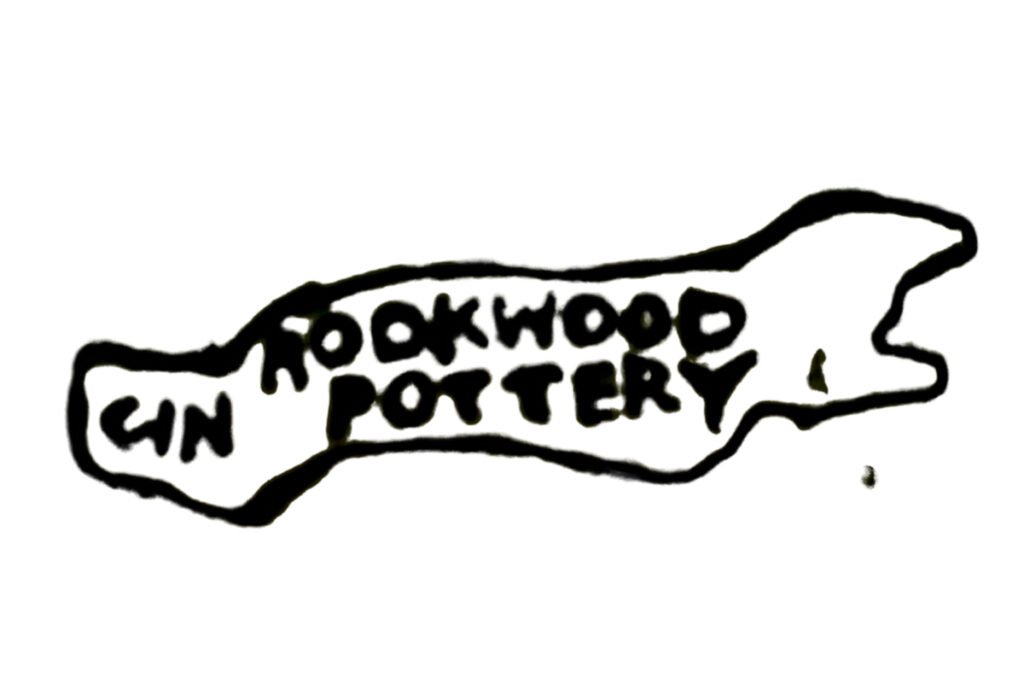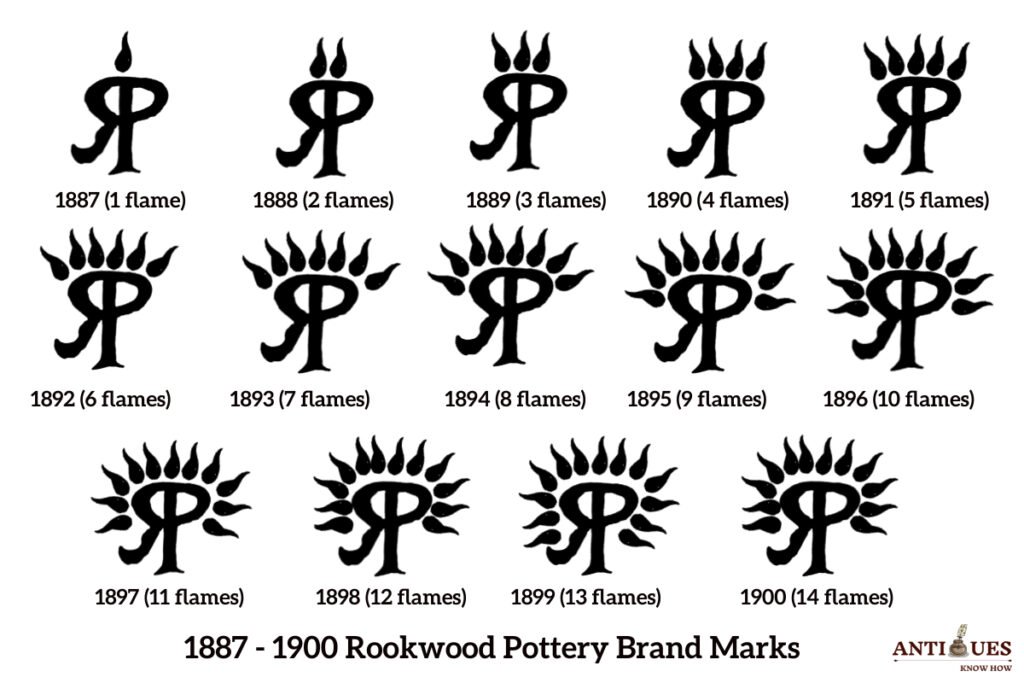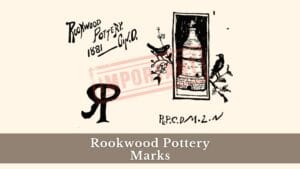Vintage ceramic gem from the late 19th & 20th centuries, the Rookwood pottery has always been highly desired by collectors. But, due to the different types of graphical, impressed marks, it gets challenging to identify a real Rookwood piece at hand.
This Rookwood marks guide will introduce you to all such crucial factory, shape, size, and series markings. And soon, you can spot a real, valuable Rookwood pottery piece without any professional help!
Key Takeaways
- Old Rookwood pottery has impressed, incised, or painted brand, series, clay, glaze, and size marks on its base.
- During 1887 – 1990, Rookwood Pottery used the iconic PR flame mark, with a new flame icon added each year.
- The Herschede Clock Company added a new relocation stamp, “Rookwood Pottery Starkville. Miss,” after shifting Rookwood’s factory location to Starkville.
- Alphabet marks like ‘Y,’ ‘X,’ and ‘U’ denote a rare Rookwood Pottery piece. But there may be other alphabet marks denoting the clay, glaze, color, and other details! Find them below!
History of Rookwood Pottery & Its Marks
Maria Longworth established the Rookwood Pottery Co. in 1880. But it wasn’t until 1887 that her company adopted standard, systematic brand marks. For the initial years, Rookwood pottery had simple hand-engraved brand names and dates.
In 1887, Longworth introduced the iconic RP flame mark, in which the flame denoted the year. Each year after 1887, a flame was added to the mark until 1900. In 1894, Rookwood also introduced a few glazes and glaze marks.
From the 1900s, Rookwood Pottery stopped adding new flames to the RP mark. Instead, it started using Roman numbers to display the years after 1900.
However, the Economic Depression took a toll on Rookwood’s sales, and the company filed for bankruptcy on April 17, 1941. In 1959, the Herschede Clock Company purchased Rookwood and introduced a new relocation mark with “Starkville. Miss.”
Today, Rookwood Pottery is over 140 years old, and the brand produces new porcelain designs in Starkville, Mississippi.
However, the original, marked Rookwood Pottery pieces come from Cincinnati, Ohio. You can identify those REAL ones by the year-wise Rookwood mark chart I’ve drawn below:
1. The Pre-1882 Rookwood Pottery Brand Marks
Before 1882, Rookwood pottery had incised or painted marks. Ceramic artists used sharp reeds to carve their initials, dates, and logos on the pottery’s base. Sometimes, they even used underglaze, relief, or Bisque finishes on top of these marks.
Learn about the earliest pre-1887 Rookwood Pottery marks hand-drawn for your reference:

Most 1881 Rookwood Pottery pieces have an incised or painted “Rookwood Pottery 1881 GND” mark with a decorator’s sign.

Many pre-1882 Rookwood Deluxe products bear a stamped “R.P.C.O.M.L.N” mark, which stands for Rookwood Pottery, Cincinnati, Ohio, Maria Longworth Nichols.
2. 1882 – 1887 Rookwood Pottery Logos & Marks
The 1882 – 1887 Rookwood Pottery had embossed, incised, and underglaze, i.e. unfired marks. The early 1883 marks had bird or kiln shapes, while the latter used impressed brand text and dates. You might also see underglaze black or brown slip along their borders.

From 1882 to 1883, Rookwood Pottery used a stamped anchor mark with a transparent slip on top.

Rare Rookwood Pottery from 1883 may have an impressed ‘Rookwood Pottery Cin’ scroll mark.

1883-1997 Rookwood Pottery Bisque pieces may bear a colored kiln mark.
This mark depicts a sketch of an old wood-fire kiln with a bird and branch on both sides.

A similar kiln mark is found on some 1883 – 1887 Rookwood pieces. This mark was impressed before the clay’s first Bisque or Biscuit firing.

Many 1882 -1885 Rookwood pieces have an impressed oval mark with the brand’s name, address, and year inscribed on it.

The early 1882 – 1886 Rookwood mark was the impressed “ROOKWOOD” mark in block letters with manufacturing date.

In 1886, Rookwood started using the stylized RP logo, with the reversed letter “R” joined with “P” at their backs.
3. The 1887- 1900 Rookwood Pottery Flame Marks
In 1887, Rookwood introduced a new brand mark with a small flame icon above the RP mark. Every year after 1887, a new flame was added to the mark until 1900.
So, to put a date on 1887 – 1900 Rookwood pieces, just count the flames! The 1887 Rookwood mark will have one flame; the 1888 mark will have two flames, and so on. The 1900 Rookwood pottery has the RP mark with 14 flames around its top.
Here’s an easy visual chart that’ll help you identify the 1887 – 1900 Rookwood marks:

4. 1900 – 1940 Rookwood Pottery Marks
From 1901, Rookwood began adding Roman numerals under their 14-flame RP mark to indicate the dating years. These carved, glazeless marks may be difficult to spot, but they can help you easily find your Rookwood piece’s age!
For example, if a Rookwood bowl has the 14 flame mark with the ‘XXIX’ numerals under it, it dates to 1929. If it has the ‘XXX’ mark, it’s from the 1930s.
The 1900-1940 Rookwood flame mark with Roman numbers looks something like this:



You might also see some raised dots, triangles, crosses, or squares under these numeral marks. Those are called the finisher’s marks and indicate that the piece was finished by a local potter or in a mold. So, these pieces have a relatively lower value.
5. 1960 Rookwood Relocation Mark
The Herschede Clock Company purchased Rookwood’s factory and ceramic-making formula in 1959. However, they shifted the factory to Starkville, Mississippi, in 1960 and introduced a new relocation mark, along with the original RP flame mark.

Rookwood Pottery pieces dating from 1960 to 1967 might have the incised “Rookwood Pottery Starkville. Miss” relocation mark. You’ll also find the RP flame icon with Roman numbers.
But remember that not all post-1960s Rookwood pieces have this mark. Some simply have handmarked names and years.
6. 1980 – 2023 Rookwood Company Marks
Modern Rookwood marks are simple. They have the incised 14-flame RP mark with the Roman year starting with ‘MM,’ indicating the 21st century.
For example, if your Rookwood figurine has an ‘MMXII’ mark, it belongs to 2012; if it has an ‘MMXV’ mark, it belongs to 2015, and so on. Here is a hand-drawn representation of the modern late 19th and 21st century Rookwood marks:



7. Rookwood Special Series Mark
Did you notice the capital letters under the RP mark above? These are Rookwood’s Special Series marks that indicate its limited-edition, trial, or unusual pieces (apart from their regular line).
Let’s learn what these letters are and what they mean:
| Rookwood Pottery Special Series Mark | Meaning |
| ‘S’ mark before the shape number | Indicates that the piece was made directly from a sketch or drawing |
| ‘S’ mark without the shape number | Used for demonstration or display-level pieces |
| ‘X’ mark on either side of the shape number | Trial or Experimental piece |
| ‘X’ mark set under the glaze | ‘Second grade’ or ‘Not for Retail’ pottery piece |
| ‘ | Indicates Rookwood gifting sets |
| ‘U’ Mark | Used for pieces with no series or shape number |
| ‘Y’ mark after the shape number | Indicates pieces made by Rookwood’s architectural department |
 | Used for Rookwood’s 50th Anniversary pieces (1930 – 1931) |
8. Rookwood Pottery Clay & Glaze Marks
Besides the series marks, you may also notice more alphabets under your Rookwood Pottery glaze. Those are the clay or glaze marks that can help you identify the type of clay, color, glaze, and top coats of your Rookwood pottery piece.
When Rookwood started its production in the 1880s, it worked only with the local Ohio clay. But when sales increased, Rookwood started using better clays to improve strength and appearance. This was when they introduced the following clay marks:
| Old Rookwood Pottery Clay Mark | Type of Clay Used |
| ‘W’ mark | White-clay bodyIris Glaze |
| ‘P’ mark | Soft Porcelain, post-1850s models |
| ‘R’ mark | Red Clay Pottery |
| ‘G’ mark | Ginger-colored Clay Body |
| ‘Y’ mark | Yellow Clay Pottery |
| ‘S’ mark | Sage green Clay Body |
| ‘O’ mark | Olive-colored Pottery |
In addition, Rookwood Pottery also has a variety of glaze marks that tell you about its final polish and appearance.
- ‘W’ mark: Denotes a cloudy, white-colored Iris glaze
- ‘Z’ mark: Used for streamlined, matte pottery
- ‘G’ mark: Indicates a glossy, sea-green glaze
- ‘V’ mark: Used for the post-1904 pieces, with a matte, textured Vellum glaze
9. Rookwood Pottery Size & Shape Marks
The post-1830s Rookwood Pottery might also have an impressed shape mark with the flame or any other brand mark on the base. Real Rookwood shape marks run from 1 to 7301 and have a transparent slip or glaze on top.
The alphabet right next to the shape number is Rookwood Pottery’s size mark. These engraved-size marks range from letters A to F, where “A” represents large pottery, and “F” represents small pieces, like bowls or other miniature pottery.
As you can see, Rookwood Pottery has quite specific marks for everything, from size and shape to manufacturing years and logos. So, using this visual marks guide, you can easily identify a valuable Rookwood by these markings.
But that’s not all! Rookwood pieces may also have an incised artist’s sign at the base, which can double their worth. Learn about all such valuable Rookwood Artists Signs in my next detailed visual guide!
Note: This article is intended for informational, educational, and entertainment purposes only. Some images are illustrative and may not represent actual brands, products, or related entities. All trademarks, product names, brand logos, packaging, and other intellectual property referenced remain the exclusive property of their respective owners. Any brand mentions or references are provided solely for descriptive and educational context and do not imply any formal or commercial association.









